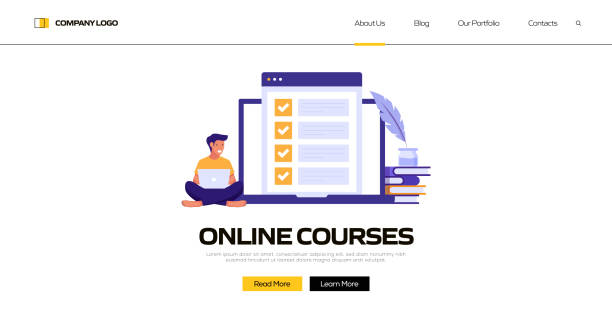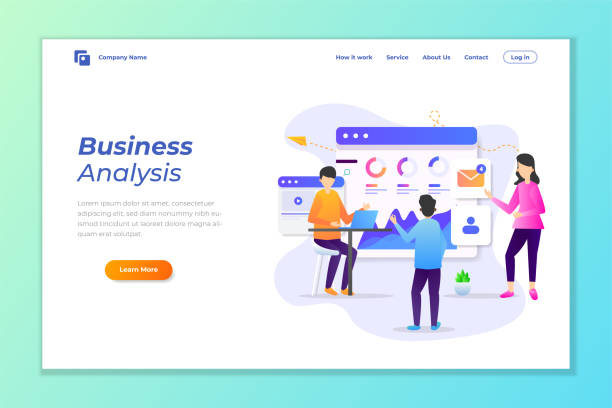Introduction to Website Design with Advanced User Experience

Modern website design with a modern user interface (#ModernWebsiteDesign #AdvancedUserInterface #UserExperience) is no longer just a luxury feature, but is considered a vital necessity in today’s digital world.
In an era where users are faced with a vast amount of information and websites, their first interaction with a website can determine its success or failure. This chapter descriptively explores the fundamental concepts of User Interface (UI) and User Experience (UX) design, demonstrating how their combination leads to the creation of websites that are not only beautiful but also efficient and user-friendly.
User Interface (UI) refers to the visual and interactive aspects of a website; elements such as buttons, menus, forms, typography, and overall layout.
The main goal of UI is to create an attractive and cohesive appearance that guides the user easily along their desired path.
In contrast, User Experience (UX) is a broader concept that encompasses all the feelings and perceptions a user has when interacting with a product or website.
This includes ease of use, efficiency, enjoyment, and even the sense of trust that the website conveys to the user.
A successful website design considers both aspects to provide an unparalleled experience for the user.
In fact, the ultimate goal of modern website design with a user interface is to build a bridge between business needs and user expectations. Websites designed with the end-user’s needs in mind have higher conversion rates, keep users on the site longer, and ultimately increase customer loyalty.
This modern approach to design goes beyond mere aesthetics, delving into user psychology to meet the complex expectations of today’s users.
Understanding these initial concepts is the first step into the dynamic world of modern website design.
A strong user interface and optimized user experience are also important from an SEO perspective.
Google’s Core Web Vitals increasingly emphasize factors such as loading speed, visual stability, and page interactivity, all of which directly relate to UI/UX quality.
This means that a modernly designed website not only satisfies users but can also achieve a better ranking in search engines.
This comprehensive approach is the foundation for building any successful website in the current era.
Did you know that your company’s website is the first point of contact for 75% of potential customers?
Your website is the face of your brand. With **Rasawweb**’s corporate website design services, build an online presence that earns customer trust.
✅ Create a professional and lasting image for your brand
✅ Attract target customers and increase online credibility
⚡ Get a free consultation from **Rasawweb** experts!
The Importance of User Interface and User Experience in Today’s Digital World

In the information age, where an online presence is vital for every business, modern website design with a modern user interface (#ImportanceOfUX #AudienceAttraction #UserInteraction) plays a fundamental role in determining the success and survival of a business.
This not only means visual beauty but also includes the overall user experience in interacting with the website.
A website with a poor user interface, even if it has fantastic content, can quickly discourage users and lead to their exit.
This chapter analytically examines various aspects of UI/UX importance in today’s highly competitive world.
The first and perhaps most important aspect is the direct impact on conversion rate.
A website that is easy to navigate, displays information clearly, and has simplified key processes (such as purchasing or registration) is more likely to convert its target users into customers.
Poor design can lead to user confusion, an increased bounce rate, and ultimately, lost sales.
A positive user experience makes users feel comfortable and confident, which is crucial for building customer loyalty.
Secondly, branding and credibility.
Your website is often the first point of contact a potential customer has with your brand.
A professionally and modernly designed website projects an image of reliability, innovation, and professionalism.
In contrast, an outdated and inefficient website can create a negative impression and harm your brand’s credibility.
In the world of social media and online reviews, a positive user experience can quickly become a powerful promotional factor, while a negative experience can quickly damage your reputation.
Finally, SEO and search engine visibility are also heavily influenced by UI/UX.
Google and other search engines increasingly consider user experience factors in their ranking algorithms.
Websites with higher Dwell Time, lower Bounce Rate, and more positive interactions tend to achieve better rankings in search results.
Therefore, investing in user interface and user experience design is not only beneficial for your users but also vital for search engine optimization and increasing traffic.
This multifaceted importance highlights the necessity of special attention to UI/UX more than ever.
Key Principles of Modern User Interface and User Experience Design

To achieve modern website design with a modern user interface (#UIPrinciples #UXRules #Aesthetics) and be successful, adhering to a set of fundamental principles is essential.
These principles not only contribute to visual appeal but also ensure that the website is not only attractive to the eye but also enjoyable and efficient to use.
This section educates on the most important of these principles that every designer and business owner should consider.
Simplicity and clarity are the first principles.
A good user interface should present information clearly and unambiguously.
Avoiding visual clutter, using appropriate whitespace, and logically organizing content help the user quickly find what they are looking for.
Nielsen’s Usability Heuristics also emphasize this principle.
The second principle is consistency and uniformity.
Design elements, including colors, fonts, buttons, and navigation patterns, should be consistent throughout the website.
This helps users quickly learn the website and feel more comfortable.
Instant feedback is also very important.
Users should always be informed about the status of their interactions with the website.
This can include a button changing color after a click, displaying a success message after form submission, or showing a progress bar for long operations.
Visual affordances that show the user how an element works (such as the appearance of a button that implies clickability) are also of high importance.
Accessibility is a principle often overlooked but vital.
A modern website should be accessible to all users, including those with disabilities.
This includes using appropriate color contrast, alternative text for images, keyboard navigation, and compatibility with screen readers.
WCAG standards provide detailed guidelines in this area.
Finally, visual and intuitive navigation allows users to move around the site easily.
Clear menus, recognizable links, and a logical hierarchical structure are the backbone of an excellent user experience.
Adhering to these principles paves the way for creating websites that are both beautiful and efficient.
In the table below, some key principles of modern UI/UX design and their brief explanations are provided:
| Principle | Description |
|---|---|
| Simplicity and Clarity | Design without clutter, aimed at quickly conveying information to the user. |
| Consistency and Uniformity | Consistent use of design elements and patterns throughout the entire website. |
| Instant Feedback | Continuous notification to the user about the status of their interactions with the site. |
| Accessibility | Ensuring the usability of the website for all users, including those with disabilities. |
| Intuitive Navigation | Logical and easy structure for user movement between pages. |
New Tools and Technologies in Modern Website Design

The world of modern website design with a modern user interface (#DesignTools #Frameworks #WebTechnology) is rapidly evolving, with new tools and technologies constantly being introduced to assist designers and developers.
Choosing the right tools can make a significant difference in efficiency, creativity, and the final quality of the product.
This chapter specializes in introducing some of the most important tools and technologies used in modern website design.
In the field of graphic design and prototyping, software like Figma, Adobe XD, and Sketch are leaders.
These tools enable UI design, wireframe creation, interactive prototypes, and team collaboration.
Figma has gained particular popularity due to its cloud collaboration capabilities and accessibility from any platform.
InVision is also a powerful platform for prototyping and gathering feedback.
In terms of front-end technologies, foundational languages like HTML5 for structure, CSS3 for styling, and JavaScript for adding dynamic interactions, still form the backbone of every website.
However, for faster and more efficient development, the use of JavaScript frameworks and libraries like React, Angular, and Vue.js has become extremely common.
These frameworks allow developers to build reusable components and develop complex, responsive web applications more quickly.
Additionally, Content Management Systems (CMS) like WordPress, using modern themes and plugins, enable the creation of attractive and high-performing websites without the need for deep coding.
For optimizing speed and performance, tools like Google PageSpeed Insights and Lighthouse are used for analysis and to provide improvement suggestions.
Finally, Design Systems, which are collections of standards, components, and guidelines, significantly help maintain consistency and increase speed in large projects.
This combination of tools and technologies is the cornerstone of every successful modern website design with a modern user interface project.
Are you tired of your company’s website not meeting your expectations? With Rasawweb, design a professional website that truly represents your business.
✅ Increase attraction of new customers and sales leads
✅ Boost your brand’s credibility and trust among your audience
⚡ Get a free website design consultation!
The Role of User Research in Optimizing User Experience

One of the most important pillars of modern website design with a modern user interface (#UserResearch #AudienceNeeds #UsabilityTesting) which is often overlooked, is user research.
Without a deep understanding of target users, their needs, behaviors, and pain points, any attempt to design an excellent user interface may go astray.
This chapter guides through the importance and various methods of user research in the UX design process.
User research is a process that involves collecting information about user behaviors, motivations, and needs.
This can be done through various methods, including User Interviews, which allow you to get closely acquainted with their perspectives; Surveys, for collecting quantitative data from a large number of users; and Observations, which involve watching users interact with a website or product.
The ultimate goal is to gain actionable insights that can directly influence design decisions.
Tools like Hotjar for heatmaps and user session recordings, or UserTesting for conducting remote usability tests, can be very helpful in this process.
Analyzing this data allows designers to identify behavioral patterns and discover weaknesses in the current or potential design.
After data collection, the next step is creating User Personas.
Personas are fictional but data-driven characters that represent different groups of your users.
They include information such as age, occupation, goals, challenges, and digital behaviors.
By having personas, designers can make their design decisions based on the actual needs of users, rather than merely on assumptions.
Finally, Usability Testing is a crucial part of user research.
In this phase, prototypes or early versions of the website are given to real users to evaluate their performance and efficiency.
The feedback from these tests is invaluable and can lead to iterative and continuous improvements.
This continuous cycle of research, design, test, and iterate ensures that the final website truly meets user needs and provides an outstanding user experience.
Responsive Design and Mobile-First Approach

In today’s world, where mobile device usage for internet access has far surpassed desktop, modern website design with a modern user interface (#ResponsiveDesign #MobileFirst #Accessibility) is incomplete without considering Responsive Design and the Mobile-First approach.
This chapter descriptively examines these two vital concepts and shows how to build websites that look great and perform flawlessly on any device.
Responsive design refers to an approach where a website is designed so that its layout and content automatically adjust to the screen size of the user’s device.
This means that a website is displayed correctly on large-screen desktops, tablets, and smartphones alike.
This is achieved using CSS Media Queries, Fluid Images, and Flexible Grids.
The main goal is for the user to have the best possible experience, regardless of the device they are using.
The Mobile-First approach is a design philosophy that suggests starting website design for the smallest screen (such as smartphones) and then gradually extending it to larger screens (tablets and desktops).
This approach contrasts with the traditional method, where design began for desktop and then was adapted for mobile.
The main reason for the popularity of the Mobile-First approach is that when designing for small screens, you are forced to prioritize essential content and features, which naturally leads to a simpler and more efficient user experience.
Furthermore, Google also places great importance on mobile compatibility and ranks websites that offer a good mobile experience higher in mobile search results (Mobile-First Indexing).
This means that a website not properly optimized for mobile not only loses mobile users but also faces SEO issues.
Therefore, the correct implementation of responsive design and adopting the Mobile-First approach is absolutely essential not only for user experience but also for visibility in search engines.
Measuring Success and Continuous Improvement of User Interface and User Experience

After implementing modern website design with a modern user interface (#KeyMetrics #DataAnalysis #ContinuousImprovement), the work is not over.
In fact, a crucial part of the process is measuring design success and making continuous improvements based on user data and feedback.
This chapter reports on key methods and tools for evaluating UI/UX performance and how to implement a data-driven approach for continuous improvement.
To measure success, you must define Key Performance Indicators (KPIs).
These indicators can include Conversion Rate, Dwell Time, Bounce Rate, number of pages visited per session, form completion rates, and the usage of specific features.
This data can be collected through web analytics tools such as Google Analytics.
A precise analysis of these statistics shows you how users interact with your website and in which sections they encounter difficulties.
In addition to quantitative data, qualitative feedback from users is also very valuable.
This feedback can be collected through surveys, interviews, focus groups, or even direct feedback forms on the website.
Tools like SurveyMonkey or Typeform can be used to create effective surveys.
After collecting and analyzing data, it’s time for optimization and A/B testing.
Optimization involves making small or large changes based on the insights gained.
A/B testing allows you to show two different versions of a page or element to different users to see which one performs better.
This scientific approach ensures that every change you implement is based on evidence and data and leads to an improved user experience.
Heatmaps and user session recordings through tools like Crazy Egg or Hotjar also provide you with a visual representation of how users interact with the website.
These tools show where users click, where they scroll, and where they get confused.
The cycle of continuous feedback and improvement not only helps maintain the website at the highest level of efficiency but also ensures that your website is always in sync with the changing needs and expectations of users.
In the table below, several key indicators for measuring UI/UX success are provided:
| Indicator | Description |
|---|---|
| Conversion Rate | The percentage of users who complete a specific action (e.g., purchase or registration). |
| Bounce Rate | The percentage of users who visit only one page and then leave the site. |
| User Dwell Time | The average time users spend on a page or the entire website. |
| Number of Pages Visited | The average number of pages a user visits in a session. |
Future Trends in Modern Website Design with a User Interface

The world of modern website design with a modern user interface (#FutureOfWebDesign #AIinUI #VirtualReality) is constantly changing and evolving, and predicting future trends is essential to staying at the forefront of innovation.
This chapter provocatively examines some of the most important upcoming trends in UI/UX that may revolutionize how we interact with websites and applications.
One of the most prominent trends is the increasing use of Artificial Intelligence (AI) and Machine Learning (ML) in optimizing user experience.
AI can be used for content personalization, suggesting relevant products, automating repetitive tasks, and even analyzing user behavior to predict their future needs.
For example, AI-powered chatbots can provide instant support and improve the user experience.
This could lead to adaptive user interfaces that automatically change based on individual user preferences and behaviors.
Another trend is Virtual Reality (VR) and Augmented Reality (AR), which are gradually making their way into web design.
Although still in their early stages, imagine e-commerce websites that allow you to virtually try on clothes or view furniture in your home before purchasing.
These technologies have great potential to create immersive and engaging experiences that go beyond today’s flat and static pages.
Voice User Interfaces (VUI) are also growing, especially with the increasing popularity of voice assistants like Siri and Alexa.
Future websites and applications may need to be controllable via voice commands, which requires a new approach to information and interaction design.
The usability of voice interfaces has its own challenges, but the convenience they offer is undeniable.
Finally, minimalist design and frictionless user experience will remain a focal point.
Users are looking for fast, smooth, and unobstructed experiences.
This means reducing unnecessary complexities, minimizing load times, and focusing on delivering core content in an effective manner.
These trends indicate that the future of modern website design with a modern user interface will be exciting, dynamic, and full of new challenges.
Are you tired of your e-commerce website not generating as much revenue for you as it could? Rasawweb, specializing in professional e-commerce website design, solves this problem for good!
✅ Increase sales rates and revenue
✅ High loading speed and unparalleled user experience
⚡ Get a free e-commerce website design consultation!
Common Mistakes in User Interface Design and Solutions to Avoid Them

Even with the best intentions and knowledge, in the process of modern website design with a modern user interface (#CommonErrors #DesignTips #AvoidingProblems) mistakes occur that can severely impact the user experience.
Identifying and avoiding these common errors is crucial for creating an efficient and user-friendly website.
This chapter entertainingly discusses some of these mistakes and practical solutions to avoid them.
One of the biggest mistakes is ignoring actual user needs.
Designing based on assumptions or a designer’s personal preferences often leads to a product that users don’t want or understand.
The solution is to always start with user research, create personas, and regularly conduct usability tests.
The user’s voice is the most important compass for design.
Another common mistake is overly complex navigation.
If users cannot easily find their way around the website, they will quickly leave it.
Avoid complex menus, too many unnecessary links, or an illogical site structure.
A simple hierarchical structure and clear menus with distinct labels are key to intuitive navigation.
Good Information Architecture can solve this problem.
Lack of mobile compatibility is also a major error.
In today’s world, a website that doesn’t look good and perform well on mobile devices is almost useless.
Be sure to use responsive design and adopt a mobile-first approach to ensure a consistent user experience across all platforms.
Mistakes in the use of colors and typography can severely reduce readability and visual appeal.
Insufficient contrast between text and background, using very small or unreadable fonts, or an inappropriate color palette can disrupt the user experience.
Adhere to visual design principles and use contrast checker tools.
Finally, ignoring feedback and lack of iteration in design hinder continuous improvement.
Design is not a static process; rather, it is an iterative and dynamic process that requires continuous attention to user needs and market trends.
By avoiding these common mistakes, you can build a website that is not only beautiful but also truly useful and enjoyable for its users.
Conclusion and a Look at the Importance of Website Design with Advanced User Experience

Throughout this article, we explored various dimensions of modern website design with a modern user interface (#ArticleSummary #FinalTips #ImportanceOfWebDesign) and saw how UI and UX, beyond mere aesthetics, are tied to the heart of an online presence’s success.
From fundamental principles to advanced tools and future trends, it became clear that investing in an unparalleled user experience is not an option but a necessity.
This concluding chapter guides by summarizing key points and emphasizing the lasting importance of this field.
As discussed, a modern and user-centric website design not only leads to increased conversion rates and customer loyalty but also plays a vital role in improving SEO rankings and website visibility in search engines.
Google and other search engines increasingly emphasize factors related to user experience, so a well-designed website will naturally perform better in search results.
This correlation between UI/UX and SEO doubles the importance of a comprehensive approach to web design.
Remember that website design is a continuous process and does not end with site launch.
Continuous user research, data analysis, and iterative improvements based on feedback and market trends are key to maintaining your website’s freshness and efficiency.
The digital world changes rapidly, and user expectations evolve at the same pace.
Therefore, flexibility and readiness to adapt to changes are hallmarks of a successful design team.
Ultimately, the main goal of modern website design with a modern user interface is to create a digital experience that captivates users, meets their needs, and establishes a deep and meaningful connection between them and your brand. By focusing on these principles, you can build websites that are not only beautiful but also guarantee sustainable success and growth for your business in today’s highly competitive online world.
This approach is a path to a bright future in the world of web.
Frequently Asked Questions
| Row | Question | Answer |
|---|---|---|
| 1 | What is meant by “modern website design with a modern user interface”? | It refers to designing a website that uses the latest trends and best practices in User Experience (UX) and User Interface (UI) to make user interaction simple, engaging, and efficient. |
| 2 | Why is a modern user interface important for a website? | A modern user interface increases user satisfaction, improves conversion rates, increases user dwell time on the site, and creates a professional and up-to-date brand image. |
| 3 | What are the key elements of a modern user interface? | Key elements include simplicity and minimalism, responsiveness, use of whitespace, attractive typography, subtle animations, a suitable color palette, and intuitive navigation. |
| 4 | What role does responsiveness play in modern UI design? | Responsiveness ensures that the website is displayed correctly on any device (mobile, tablet, desktop) and provides a seamless user experience, which is essential for modern UI. |
| 5 | How important is typography in modern UI design? | Typography plays a very important role in readability, visual hierarchy, and brand visual identity. Modern fonts and their combinations can contribute to the overall beauty and attractiveness of the site. |
| 6 | How are animations and micro-interactions used in modern design? | Animations and micro-interactions are used to create visual feedback, guide the user, and add a sense of dynamism and appeal to the user interface, provided they are not excessive. |
| 7 | What is the role of User Experience (UX) in modern UI design? | UX is the foundation of modern UI. A modern design must first be functional, understandable, and enjoyable (UX), and then beautiful and appealing (UI). |
| 8 | What tools are used for modern UI design? | Tools like Figma, Adobe XD, Sketch, and InVision are used for design, and frameworks like React, Vue.js, or Angular are used for implementation. |
| 9 | How can overly complex design be avoided in a modern user interface? | By focusing on minimalism, removing unnecessary elements, using plenty of whitespace, and adhering to the “Less is More” principle. |
| 10 | What is the importance of user testing in modern UI design? | User testing ensures that the designed user interface is truly useful, understandable, and engaging for users, and that potential issues are addressed before launch. |
And other services of Rasawweb Advertising Agency in the field of advertising
Smart Marketing Automation: Designed for businesses seeking online growth through user experience customization.
Smart Social Media: An innovative service to increase sales through custom programming.
Smart SEO: A dedicated service to boost website traffic based on intelligent data analysis.
Smart Customer Journey Map: A fast and efficient solution to increase website traffic by focusing on optimizing key pages.
Smart Social Media: Transform click-through rates with attractive UI design.
And over a hundred other services in online advertising, advertising consultation, and organizational solutions
Online Advertising | Advertising Strategy | Advertorials
Resources
Modern website design with an audience attraction approach
Importance of user interface in website design
UI and UX design principles for websites
Strategies for attracting users to a website
? For your business to soar in the digital world and achieve unprecedented success, Rasawweb Afarin Digital Marketing Agency is by your side with its expertise and experience. From user-friendly website design and SEO optimization to executing targeted advertising campaigns, we are ready to transform your brand in the online space and pave the way for sustainable growth.
For consultation and services, contact us.
📍 Tehran, Mirdamad Street, Next to Central Bank, Southern Kazeroun Alley, Ramin Alley, No. 6



